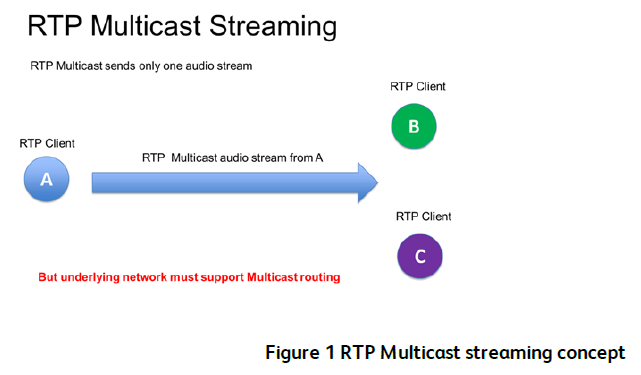Categories
New Blog
IP Multicast for RTP Streaming
November 11 , 2021What is IP Multicast?
IP Multicast is a method of sending Internet Protocol (IP) datagrams to a group of interested receivers in a single transmission. It is the IP-specific form of multicast and is used for streaming media and other network applications. It uses specially reserved multicast address blocks in IPv4 and IPv6.
The most common transport layer protocol to use multicast addressing is User Datagram Protocol (UDP). By its nature, UDP is not reliable—messages may be lost or delivered out of order. Reliable multicast protocols such as Pragmatic General Multicast (PGM) have been developed to add loss detection and retransmission on top of IP multicast.

IPv4 Multicast addresses
Host Extensions for IP Multicasting [RFC1112] specifies the extensions required of a host implementation of the Internet Protocol (IP) to support multicasting. The multicast addresses are in the range 224.0. 0.0 through 239.255. 255.255.
What is RTP Multicast?
RTP Multicast
Multicast-based protocols
Since multicast is a different transmission mode from unicast, only protocols designed for multicast can be sensibly used with multicast. Most of the existing application protocols that use multicast run on top of the User Datagram Protocol (UDP).
In many applications, the Real-time Transport Protocol (RTP) is used for framing of multimedia content over multicast; the Resource Reservation Protocol (RSVP) may be used for bandwidth reservation in a network supporting multicast distribution. Multicast DNS (mDNS) can be used to resolve domain or host names without a dedicated DNS server by using multicast.。
RTP is designed for end-to-end, real-time transfer of streaming media. The protocol provides facilities for jitter compensation and detection of packet loss and out-of-order delivery, which are common especially during UDP transmissions on an IP network. RTP allows data transfer to multiple destinations through IP multicast.[1] RTP is regarded as the primary standard for audio/video transport in IP networks and is used with an associated profile and payload format.[2] The design of RTP is based on the architectural principle known as application-layer framing where protocol functions are implemented in the application as opposed to in the operating system's protocol stack.

Tonmind IP Speaker supports RTP Multicast, thus can be compatiblle with Axis software. Our IP Speaker supports various codec inclduing OPUS, G711U, G711A, G722, GSM, MP1, MP2, MP3, WAV, LPCM s16le, etc. Compared to other IP Speaker in market, most of them do not have OPUS codec. Our 48K OPUS Audio Codec enables excellent sound quality .
Tonmind aim to provide cost-effective, consistent and reliable IP PoE speaker to our distributors. Our R&D team will be strong support for excellent product quality and compatibity. Our engineers have been devoted to upgraded software for better user experience.
Tonmind SIP Paging Speaker includes various types, including ceiling, wall mounted and horn version. There are 15W and 30W optional. And the horn version can be used for outdoors that is IP67 waterproof. If you are interested in more details and application, welcome to send an enquiry to us via email sales@tonmind.com.